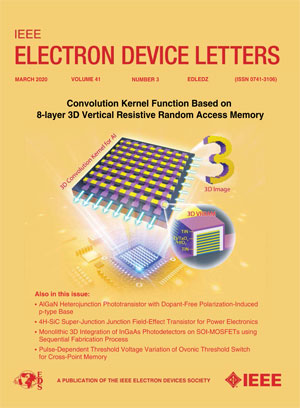2.4 kV β-Ga2O3 SBDs With 1.22 GW/cm2 Figure of Merit by N2O Plasma Treatment
IF 4.5
2区 工程技术
Q2 ENGINEERING, ELECTRICAL & ELECTRONIC
引用次数: 0
Abstract
This work reports the effect of N2O plasma treatment at different temperatures on the performance ofN2O等离子体处理的2.4 kV β-Ga2O3 sbd性能图为1.22 GW/cm2
本文报道了不同温度下N2O等离子体处理对$\beta $ -Ga2O3肖特基势垒二极管(sbd)性能的影响。结果表明,经过$300~^{\circ}$ C N2O等离子体处理后,器件漏电流由$4\ × 10^{-{9}}$降低到$4\ × 10^{-{10}}$ /cm2,通断比由$6\ × 10^{{10}}$提高到$5\ × 10^{{11}}$。由于氮离子和氧离子钝化了表面态和氧空位,载流子浓度从${2}开始下降。{20}\乘以{10}^{{16}}$到${1}。{61}\times {10} ^{{16}}$ cm ${}^{-{3}}$。这种改进是由于在样品表面形成了大量的Ga-N键,从而产生了高电阻n掺杂的$\beta $ -Ga2O3层。这进一步提高了器件击穿电压(V ${}_{\text {br}}\text{)}$从664 V到2,437 V,功率优值(PFOM)为1.22 GW/cm2。我们的击穿电场(E ${}_{\text {br}}\text{)}$是目前报道的无端接结构的垂直$\beta $ -Ga2O3 sdd器件中最高的,Vbr是相同外延厚度器件中最高的。
本文章由计算机程序翻译,如有差异,请以英文原文为准。
求助全文
约1分钟内获得全文
求助全文
来源期刊

IEEE Electron Device Letters
工程技术-工程:电子与电气
CiteScore
8.20
自引率
10.20%
发文量
551
审稿时长
1.4 months
期刊介绍:
IEEE Electron Device Letters publishes original and significant contributions relating to the theory, modeling, design, performance and reliability of electron and ion integrated circuit devices and interconnects, involving insulators, metals, organic materials, micro-plasmas, semiconductors, quantum-effect structures, vacuum devices, and emerging materials with applications in bioelectronics, biomedical electronics, computation, communications, displays, microelectromechanics, imaging, micro-actuators, nanoelectronics, optoelectronics, photovoltaics, power ICs and micro-sensors.
 求助内容:
求助内容: 应助结果提醒方式:
应助结果提醒方式:


